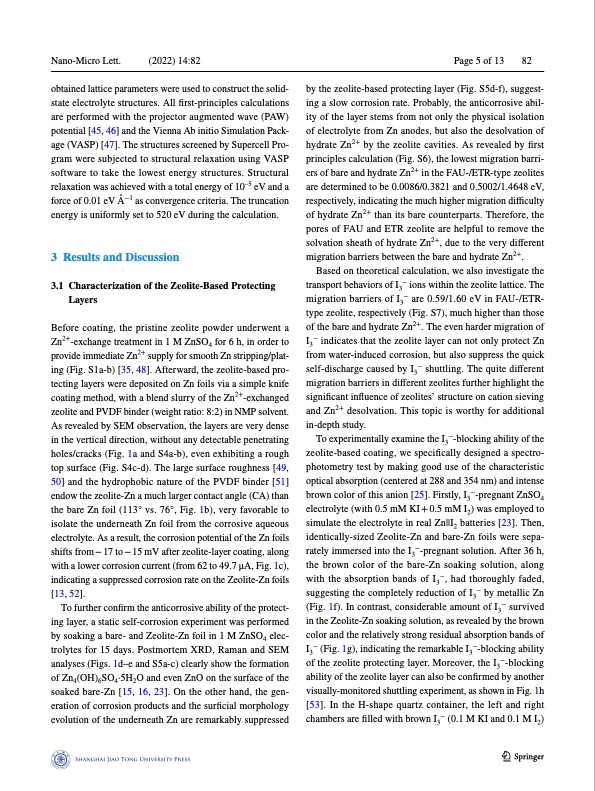
PDF Publication Title:
Text from PDF Page: 005
Nano-Micro Lett. (2022) 14:82 obtained lattice parameters were used to construct the solid- state electrolyte structures. All first-principles calculations are performed with the projector augmented wave (PAW) potential [45, 46] and the Vienna Ab initio Simulation Pack- age (VASP) [47]. The structures screened by Supercell Pro- gram were subjected to structural relaxation using VASP software to take the lowest energy structures. Structural relaxation was achieved with a total energy of 10–5 eV and a force of 0.01 eV Å−1 as convergence criteria. The truncation energy is uniformly set to 520 eV during the calculation. 3 Results and Discussion 3.1 Characterization of the Zeolite‐Based Protecting Layers Before coating, the pristine zeolite powder underwent a Zn2+-exchange treatment in 1 M ZnSO4 for 6 h, in order to provide immediate Zn2+ supply for smooth Zn stripping/plat- ing (Fig. S1a-b) [35, 48]. Afterward, the zeolite-based pro- tecting layers were deposited on Zn foils via a simple knife coating method, with a blend slurry of the Zn2+-exchanged zeolite and PVDF binder (weight ratio: 8:2) in NMP solvent. As revealed by SEM observation, the layers are very dense in the vertical direction, without any detectable penetrating holes/cracks (Fig. 1a and S4a-b), even exhibiting a rough top surface (Fig. S4c-d). The large surface roughness [49, 50] and the hydrophobic nature of the PVDF binder [51] endow the zeolite-Zn a much larger contact angle (CA) than the bare Zn foil (113° vs. 76°, Fig. 1b), very favorable to isolate the underneath Zn foil from the corrosive aqueous electrolyte. As a result, the corrosion potential of the Zn foils shifts from − 17 to − 15 mV after zeolite-layer coating, along with a lower corrosion current (from 62 to 49.7 μA, Fig. 1c), indicating a suppressed corrosion rate on the Zeolite-Zn foils [13, 52]. To further confirm the anticorrosive ability of the protect- ing layer, a static self-corrosion experiment was performed by soaking a bare- and Zeolite-Zn foil in 1 M ZnSO4 elec- trolytes for 15 days. Postmortem XRD, Raman and SEM analyses (Figs. 1d–e and S5a-c) clearly show the formation of Zn4(OH)6SO4·5H2O and even ZnO on the surface of the soaked bare-Zn [15, 16, 23]. On the other hand, the gen- eration of corrosion products and the surficial morphology evolution of the underneath Zn are remarkably suppressed Page 5 of 13 82 by the zeolite-based protecting layer (Fig. S5d-f), suggest- ing a slow corrosion rate. Probably, the anticorrosive abil- ity of the layer stems from not only the physical isolation of electrolyte from Zn anodes, but also the desolvation of hydrate Zn2+ by the zeolite cavities. As revealed by first principles calculation (Fig. S6), the lowest migration barri- ers of bare and hydrate Zn2+ in the FAU-/ETR-type zeolites are determined to be 0.0086/0.3821 and 0.5002/1.4648 eV, respectively, indicating the much higher migration difficulty of hydrate Zn2+ than its bare counterparts. Therefore, the pores of FAU and ETR zeolite are helpful to remove the solvation sheath of hydrate Zn2+, due to the very different migration barriers between the bare and hydrate Zn2+. Based on theoretical calculation, we also investigate the transport behaviors of I3− ions within the zeolite lattice. The migration barriers of I3− are 0.59/1.60 eV in FAU-/ETR- type zeolite, respectively (Fig. S7), much higher than those of the bare and hydrate Zn2+. The even harder migration of I3− indicates that the zeolite layer can not only protect Zn from water-induced corrosion, but also suppress the quick self-discharge caused by I3− shuttling. The quite different migration barriers in different zeolites further highlight the significant influence of zeolites’ structure on cation sieving and Zn2+ desolvation. This topic is worthy for additional in-depth study. − To experimentally examine the I3 -blocking ability of the zeolite-based coating, we specifically designed a spectro- photometry test by making good use of the characteristic optical absorption (centered at 288 and 354 nm) and intense brown color of this anion [25]. Firstly, I3−-pregnant ZnSO4 electrolyte (with 0.5 mM KI + 0.5 mM I2) was employed to simulate the electrolyte in real Zn||I2 batteries [23]. Then, identically-sized Zeolite-Zn and bare-Zn foils were sepa- rately immersed into the I3−-pregnant solution. After 36 h, the brown color of the bare-Zn soaking solution, along with the absorption bands of I3−, had thoroughly faded, suggesting the completely reduction of I3− by metallic Zn (Fig. 1f). In contrast, considerable amount of I3− survived in the Zeolite-Zn soaking solution, as revealed by the brown color and the relatively strong residual absorption bands of I3− (Fig. 1g), indicating the remarkable I3−-blocking ability of the zeolite protecting layer. Moreover, the I3−-blocking ability of the zeolite layer can also be confirmed by another visually-monitored shuttling experiment, as shown in Fig. 1h [53]. In the H-shape quartz container, the left and right chambers are filled with brown I3− (0.1 M KI and 0.1 M I2) 13PDF Image | Boosting Zn Battery by Coating a Zeolite‐Based Cation‐Exchange

PDF Search Title:
Boosting Zn Battery by Coating a Zeolite‐Based Cation‐ExchangeOriginal File Name Searched:
Shang2022_ZnI-Battery.pdfDIY PDF Search: Google It | Yahoo | Bing
CO2 Organic Rankine Cycle Experimenter Platform The supercritical CO2 phase change system is both a heat pump and organic rankine cycle which can be used for those purposes and as a supercritical extractor for advanced subcritical and supercritical extraction technology. Uses include producing nanoparticles, precious metal CO2 extraction, lithium battery recycling, and other applications... More Info
Heat Pumps CO2 ORC Heat Pump System Platform More Info
| CONTACT TEL: 608-238-6001 Email: greg@infinityturbine.com | RSS | AMP |